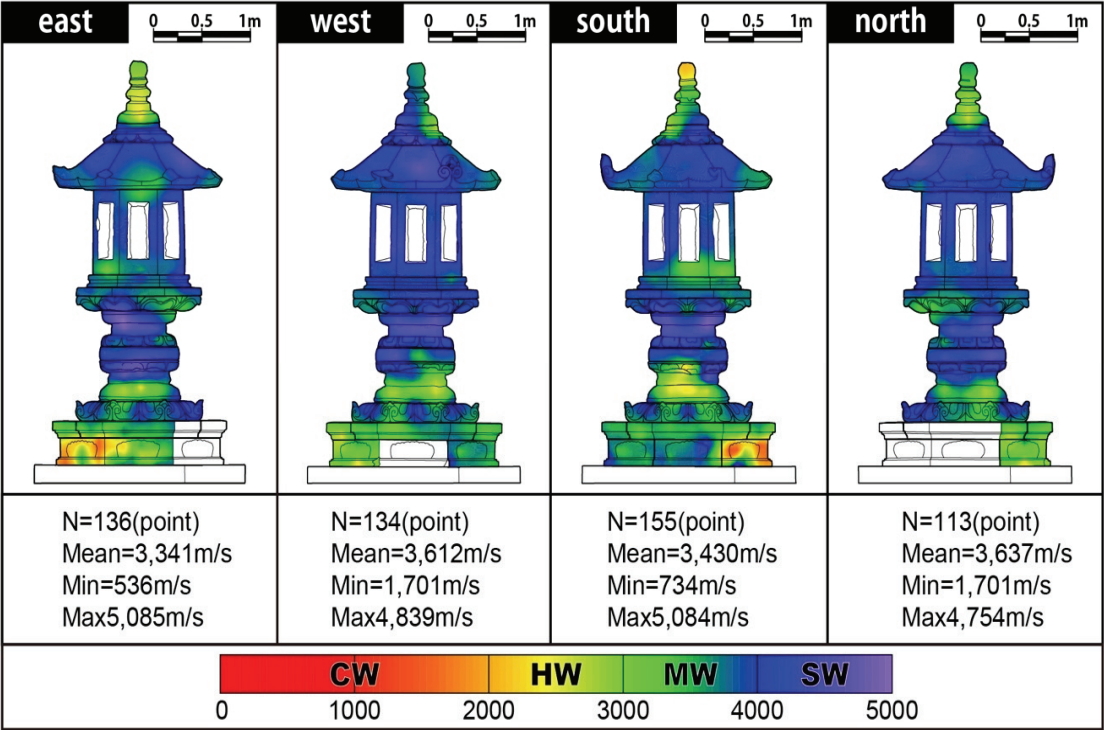 |
 |
- Search
| J. Conserv. Sci > Volume 35(4); 2019 > Article |
|
ABSTRACT
The stone lantern of the Damyang Gaeseonsaji temple site is a cultural heritage built during the Unified Silla period (AD 868). The reason for its value as a cultural property is due to wittern the background and the period created on inscription of the lamp stone engraved by letters. The stone lantern consists of two types of lithic tuffs for the 23 original properties, the replaced stones in 1991, and the biotite granite for its ground stones replaced in 2005. The lithic tuffs selected as the replacement parts in 1991 and 2017 have been examined and got to properties of hardly exposure moisture as well as very similar geochemical characteristics. There were various types of physical deterioration of the stone properties and structural cracks; in particular, on the northern side of the stylobates. Chemical and biological deterioration can be identified as black, white, and brown discolorations as well as by the presence of lichens, bryophytes, and herbaceous plants. In the evaluation of the physical properties of the stone lantern, the mean and maximum ultrasonic velocities were found to be similar in each direction. However, the lowest velocity on the east and south sides were found to be lower than those of other stone properties. It was found that physical damage to the stylobates resulted from water expansion in a freeze-to-thaw phenomena related to water content. Therefore, dismantling repair was carried out in the protection facility to restrict further water supply to the stone as much as possible.
The Damyang Gaeseonsaji(Gaeseon temple site) stone lantern is located in Damyang, Jeollanam-do, Republic of Korea. It is a stone lantern of the Unified Silla period(868 AD), designated as Korean Treasure No. 111 in January, 1963. This stone lantern is the sole stone lantern of the Unified Silla period whose year and historical background are known owing to the existence of an inscription of its construction record. It is a precious reference that can be used as a standard for the stone cultural heritages of the same period and similar styles. While the stone cultural heritages of Korea are mainly composed of granitic rocks, the original stone materials of the Gaeseonsaji stone lantern are tuffaceous rocks, which have relatively weak properties. As the physical deterioration was serious on this stone lantern, it was dismantled several times to perform conservation treatment and stone replacement.
According to this stone lantern’s record in the atlas of archaeological sites in Joseon dynasty(Joseon-gojeok-dobo), its Ganjuseok(the pillar stone of the stone lantern) was in a buried state. In 1965, the scattered stone properties were collected and the damaged parts were repaired using cement(Kim, 2005). In 1989, construction work that involved ground-cutting and the installation of a water drainage system was performed, and in 1991, end-to-end repair works were performed. Some parts were replaced with tuffaceous rocks, which originated from a different place than the original stones. Moreover, the broken-off stone parts were filled with conservation treatment materials. As deterioration had occurred on the Jidaeseok(the ground stone of the stone lantern) among the stone properties replaced in 1991, it was dismantled and repaired again in 2005 to replace it. The Jidaeseok was replaced with granite, which has a lower water absorption rate than the tuff(Cultural Heritage Administration, 1993; National Research Institute of Cultural Heritage, 2001).
Although dismantling, conservation treatment, and stone replacement works had been performed several times over a long period until recently, the exact cause of the damage was not identified. Moreover, as the works were repair-oriented, the damage had continually occurred to the stones of the stone lantern. Hence, a dismantling and repairing work was started in 2016 and finished in 2017 with the goal of replacing the Hadaeseok(the lower foundation stone of the stone lantern, which supports the pillar or Ganjuseok) based on the evaluation report that the physical damage on the Hadaeseok were serious and caused structural instability.
At that time, an attempt was made again to use granites having good properties as the replacement stones of Hadaeseok, but as the historical value would be lost if heterogeneous granite were used, it was suggested to replace it with an original material or tuff similar to the replacement stones used in 1991. However, as it was difficult to obtain rocks similar to the replacement stones of 1991, replacement had to be performed with tuff from another region. Hence, tuffaceous rocks quarried in Jangheung, Jeollanam-do were used; they had similar petrographic characteristics as the replacement stones of 1991. Furthermore, a precision diagnosis of this stone lantern, which had not been performed until that time, was required so that the damage would not be repeated.
Therefore, this study investigated the material characteristics of the stone components of the stone lantern before the dismantling and repairing work in 2016, investigated the cause of the damage that occurred on the Hadaeseok, and examined the petrographic characteristics of the stones planned to be used as replacements through non-destructive evaluation. In addition, based on the analysis results, an appropriate conservation method was proposed and applied to the dismantling and repairing work. The results of this study can be used as an important reference for damage diagnosis of stone cultural assets and the selection of new repairing stones.
The Gaeseonsaji stone lantern is located in Hakseon-ri, Nam-myeon, Damyang-gun, Jeollanam-do, Republic of Korea. The Gaeseonsaji(Gaeseon temple site) is surrounded by mountains and is adjacent to Gwangju Lake in the east and Gwangju Metropolitan City in the west. The stone lantern is located at a lower part of a topographically concave ridge. As the surrounding area has been used as farmland for a long time, its environment is prone to hold water, and a water drainage system was installed in 1989 to lower the surrounding ground of the stone lantern.
Although there is almost no historical record of the Gaeseonsaji stone lantern, there are inscriptions on the Hwasaseok(the lamp stone, which is the upper part of the stone lantern where the fire is lit). The inscriptions state that the stone lantern was built by the royal family in the eighth year of King Gyeongmun’s reign(868 AD) and describe the information regarding its cost and the person who was in charge of its construction. Furthermore, a variety of information was recorded regarding the land buyer and owner at the time, cost, location, and area(Koo, 2000;Kim, 2005). Among the stone lanterns of the Unified Silla period, the Gaeseonsaji stone lantern is the only one that has inscriptions for the year and historical background information.
As this stone lantern was dismantled and repaired twice in recent years alone, different rock types and a large amount of repair materials can be observed in every member of the stone lantern. This stone lantern had a total of 23 stone parts; the drum-shaped Ganjuseok of Jungdaeseok(the middle foundation stone of the stone lantern) and the Hadaeseok were replaced in 1991 and the Jidaeseok was replaced in 2005(Figure 1). Furthermore, Sangryunbu(the stone in top part of the stone lantern), Sangryun-bachimseok(the supporting stone in the top part of the stone lantern), and the double-headed-drum-shaped Ganjuseok of Hadaeseok were bonded with cement and synthetic resin in the dismantling and repairing process of 1991. There were traces of bonding of the cracks on the Hwasaseok, on which the inscriptions were engraved, and the double-headed-drum-shaped Ganjuseok of Sangdaeseok(the upper foundation stone of the stone lantern).
In this study, a portable stereoscopic microscope(AD7013 MZT, Dino-Lite, TWN) was used to observe the petrogrphical characteristics and microstructure of the stone materials composing the Gaeseonsaji stone lantern and the replacement stones of 2017. Furthermore, exfoliated micro samples were collected and structural characteristic was observed by using a polarizing microscope. In addition, X-ray diffraction (XRD) analysis was performed to identify the mineralogical composition of the stone lantern. The devices used for the analysis were dual-purpose polarizing and reflecting microscope (Eclipse E600W, Nikon, JPN) and D/Max-IIB(Rigaku, JPN). The X-ray source was Cu Kα, and the voltage and current were set at 40 kV and 100 mA, respectively.
To investigate the micro-magnetic susceptibility of stone materials, the whole-rock magnetic susceptibility was measured. The measuring instrument was ZH Instrument(CZE) SM30, and the unit of magnetic susceptibility was 10-3 SI unit. Furthermore, an inductively coupled plasma-atomic emission spectrometer (ICP-AES), an inductively coupled plasma-mass spectrometer (ICP-MS), and instrumental neutron activation analysis (INAA) were used for a quantitative analysis of the major, minor, and rare earth elements of the rocks. The water absorption, porosity, and pore size distribution were measured to investigate the original physical properties of the rocks. The Archimedes’ method was applied to measure the water absorption rate and the porosity, and mercury intrusion porosimetry was used to measure the pore size distribution. The measuring instrument was Auto Pore 9529(Micrometrics, USA).
A deterioration map was composed to record the information for the deterioration of the stone lantern. First, 3D image analysis was performed by using a 3D scanner to acquire and record precise survey drawings of the stone lantern. The precision level of scan was set to 4 mm horizontally and 6 mm vertically, and the scanning was performed in eight directions including all four cardinal directions and the diagonal directions. In addition, scanning was performed by adding four points partly to capture the images of the lower part of Yeonhwa (lotus pattern) Sangdaeseok.
The deterioration drawing was composed by recording the physical, chemical, and biological deterioration information acquired from the on-site survey, and the overall deterioration rate was calculated. Infrared thermography analysis was performed by using Flir B200(FLIR Systems, USA) to investigate the exact area of the exfoliated part confirmed through the deterioration map. The contaminants on the surface of the stone lantern were precisely analyzed by using portable X-ray fluorescence (P-XRF). Furthermore, a tiny amount of the exfoliated sample was collected, and then scanning electron microscopy (SEM) and energy-dispersive X-ray spectroscopy (EDS) observations were obtained.
In addition, ultrasonic velocity measurement was performed to evaluate the properties of the stones composing the stone lantern. Based on the ultrasonic velocity converted from the indirect method to the direct method, conversion to the weathering index was performed, and it was recorded in 2D on the survey drawing. Here, the fracture zone on the platform was skipped, considering the possibility of secondary damage occurring owing to the measurement, and the measurement was performed at a total of 356 points. The measuring instrument was Pundit Lab(Proceq, CHE)
The Gaeseonsaji stone lantern has undergone repairs several times, and it consists of tuff, which is the original material, and tuff and biotite granite, which are the replacement materials. The tuffs of the original material and the replacement properties have some differences in their rock and mineralogical characteristics. This study performed naked-eye investigation and stereoscopic microscope observation for a tiny piece of tuff broken off from the original stone, which was collected as a sample, and for the tuff used as the replacement material of Hadaeseok in 1991 and 2017. Furthermore, a polarizing microscope observation was performed to investigate the microstructure and mineralogical composition of the component rocks, which were difficult to identify with the naked eye (Figure 2).
The sample name for the original material was designated as KS-T1, that of the replacement material of 1991 as KS-T2, and that of the replacement material of 2017 as KS-T3. The original material(KS-T1) had a grayish green color and consisted of felsic minerals such as quartz and plagioclase, and white and black rock fragments of size approximately 1 cm(Figure 2A, 2B). The main rock-forming minerals were fine-grained quartz, orthoclase, and plagioclase. The matrix included colorless mineral fragments of size less than 0.2 mm(Figure 2C).
The replacement material of 1991 had a light-green color overall and consisted of fine-grained felsic minerals and rock fragments. The size of the green altered minerals and rock fragments varied from less than 1 mm to approximately 3 cm. The grains of the rock-forming minerals were fine-grained in terms of grain size, and a matrix of green color showing weak directivity was partially observed(Figure 2D, 2E). The major rock-forming minerals were fine-grained quartz, orthoclase, and plagioclase. The matrix was composed of cryptocrystalline or hyaline volcanic ash, and mineral fragments of size less than 1 mm were partially observed(Figure 2F).
The replacement material of 2017(KS-T3) had a light grayish green color overall and consisted of fine-grained felsic minerals and heterogeneous rock fragments. The grain size varied from approximately 1 mm to 5 cm, and hyaline green rock fragments showing a certain directivity were observed(Figure 2G, 2H). The major component minerals were fine-grained quartz, orthoclase, and plagioclase. The matrix consisted of cryptocrystalline or hyaline volcanic ash, and mineral fragments of size less than 1 mm were observed(Figure 2I).
For a precise identification of the rock-forming minerals, XRD analysis was performed by grinding the collected rock samples into powder. Consequently, quartz, K-feldspar (orthoclase), and plagioclase were detected as the main component minerals in every sample, similar to the polarizing microscope observation result(Figure 3). Considering the overall lithology, rock-forming minerals, and structural characteristics, all the materials were very similar lithic tuffs. Furthermore, the replacement materials used for Hadaeseok in 1991 and 2017 were rocks having very similar rock and mineralogical characteristics.
The whole-rock magnetic susceptibility was measured to investigate the micro-magnetic characteristics of the tuffaceous rocks composing the Gaeseonsaji stone lantern(Figure 4). The magnetic susceptibility is a constant that determines the magnetic property of rock and is affected by the content of ferromagnetic minerals appearing as opaque minerals among the rock-forming minerals. As an effective method of investigating the homogeneity by identifying the material property characteristics of rocks, it has been used for the original form restoration of cultural heritages through application to the analysis of the place-of-origin of stone cultural heritages in Republic of Korea and overseas(Lee et al., 2007; 2010; Uchida et al., 2007). Furthermore, a study has applied it to tuffaceous stone cultural heritages to examine the homogeneity of stone materials(Park et al., 2012).
The magnetic susceptibility was measured 300 times at 195 points targeting all the parts of each material and 105 points for KS-T3. In the results, KS-T1 showed a distribution in the range of 0.24 to 0.86(mean 0.53 × 10-3 SI unit). KS-T2 corresponded to the range of 0.08 to 0.33(mean 0.18 × 10-3 SI unit) and showed partially similar magnetic susceptibility distribution. KS-T3 showed the range of 2.76 to 9.42(mean 6.39 × 10-3 SI unit), demonstrating very different magnetic susceptibility from the aforementioned two types of tuff(Figure 4). It is interpreted as a characteristic appearing when there is a regional difference even if the stone materials have similar rock and rock-forming mineral compositions.
One of the weathering characteristics of soft rocks such as tuff is the powdering phenomenon. The powdering phenomenon of rock occurs as drying and water absorption are repeated and is a phenomenon of decomposition into particle phase along tiny cracks. It is known that there are many causes of this process, such as clay minerals, micro-pore diameter distribution, and capillarity, but further studies are required to determine its exact mechanism. Nevertheless, it is certain that it occurs as water absorption and drying are repeated. Therefore, to investigate this physical property, this study analyzed the water absorption, porosity, and micro-pore diameter distribution of the rocks(Figure 5).
The water absorption and porosity were analyzed using the Archimedes’ method, and the diameter distribution of the micro-pores was investigated by using mercury intrusion porosimetry. KS-T1 was excluded because the amount of analysis sample was insufficient. The porosity was determined to be 9.09% for KS-T2 and 8.87% for KS-T3, which were very similar and were consistent with the porosity distribution of normal tuff. The water absorption was 5.5% for both materials, showing a lower value than that of normal tuff.
However, the micro-pore diameter distribution showed a tiny difference. KS-T2 showed a distribution mainly in the region between 121 nm and 283 nm, whereas KS-T3 showed a distribution in the region between 40 nm and 120 nm. Although there was some difference, the two samples indicated that they were all porous rocks having micro-pores. When a rock has a pore size of less than 5 μm, the outflow of water existing inside pores is difficult(National Highway Cooperative Research Program, 1969). Although these rocks did not have high water absorption, the outflow of water was difficult because the micro-pore diameter distribution was less than 5 μm.
Chemical analysis was performed to investigate the petrological similarity and weathering characteristics of the original material and the replacement materials of the Gaeseonsaji stone lantern(Table 1). First, to compare the major and minor element contents and examine the enrichment and deficiency patterns of each element, normalization was performed based on the average content of granite rocks presented by Nockolds(1954) and Govindaraju(1989).
It was observed that only the trend of MgO was somewhat different and a majority of the elements showed similar trends. KS-T2 showed an enrichment of Fe2O3(T), MgO, and CaO whereas KS-T3 showed a deficiency of these components. Furthermore, a trend was shown that TiO2 was enriched, and Na2O and K2O became deficient, but the enrichment factors were different. Even for minor elements, the enrichment factors were different, and the trends showed some differences(Figure 6).
As a result of normalizing based on the initial ratios of meteorite presented byTaylor and Maclennan(1985) to compare the rare earth elements, similar behavior characteristics were shown, but the KS-T3 sample showed relatively enriching trends. Moreover, when the compatible and incompatible elements were normalized based on the primitive mantle composition presented by Pearce(1983), the two samples showed the same behavior characteristics(Figure 6). Therefore, although the composition of the elements was slightly different between these tuffaceous rocks, it was confirmed that the rock series were all distributed in the domain of rhyolite rocks.
Various types of physical deterioration such as structural cracks, delamination cracks, micro-cracks, exfoliation, flakes, and break out occurred on the Gaeseonsaji stone lantern. The structural and exfoliation cracks developed on the stone lantern were observed mainly on the Hadaeseok replaced in 1991, and the micro-cracks appeared mainly on the original material. Particularly, as break-off had occurred along the cracks on the Hadaeseok, structural instability was of concern(Figure 7A).
Furthermore, physical deterioration such as flaking and exfoliation occurred again on the stone parts filled with conservation treatment materials used when repairing the stone lantern in 1991(Figure 7B). Cracks and exfoliation had occurred at the double-headed Ganjuseok of Hadaeseok, and they appeared to be effects of the load at the upper part(Figure 7C). As such, thermography analysis was performed to investigate the exact locations and areas of the exfoliations occurring internally(Figure 7D to 7I).
A hot object can emit higher energy than visible light, and because the air layer of the exfoliated part has small thermal capacity, it reacts sensitively to the external temperature. The area of exfoliation can be determined by capturing an infrared thermal image of the exfoliated part using this principle(Lee et al., 2012;Jo et al., 2013;Jo and Lee, 2014). First, the exfoliation was checked using the percussion method, and microscopic temperature distribution was investigated by applying heat.
Consequently, exfoliation was detected at the parts that could not be seen with the naked eye on the original and replacement stones(Figure 7G, 7H, 7I). Particularly, broad exfoliation was under progress inside the Hadaeseok. As a result of conducting precise temperature analysis for the representative measurement points, it was confirmed that the peak increased sharply on the temperature distribution curve (Figure 7G). This high-temperature area showed a relatively high temperature compared with the surface temperature of all the fresh parts. In particular, when the high-temperature area of the white and red colors in the exfoliated part and the temperature of the fresh part were examined, the high-temperature area showed high temperatures of 35.0℃ and 30.6℃, and the fresh area points showed a low temperature distribution with 27.8℃ and 26.6℃.
Chemical deterioration such as black, white, and brown discoloration occurred on the stone surface of the Gaeseonsaji stone lantern. The black discoloration was mainly observed on the Okgaeseok(roof stone), Hwasaseok(lamp stone), and Hadae-sangseok(the upper stone of the foundation part of the stone lantern, which supports the pillar), and particularly, some of the black discoloration observed on the Okgaeseok was likely to have been caused by mortar used when the upper part of the stone lantern(Sangryunbu) was repaired(Figure 8A). Furthermore, the black discoloration observed on the Hadae-sangseok was caused by the structure with which it was easy to gather and hold water. In the Hwasaseok of the stone lantern, black discoloration caused by the carbides produced as the fire was lit was observed, and black and brown discolorations were observed on the lower part of the Okgaeseok. The white discoloration appeared mainly inside the Hwasaseok, on which the inscriptions were engraved(Figure 8B, 8C).
P-XRF was used to perform an elemental analysis to investigate the cause of the surface discoloration. Although P-XRF cannot measure the light elements, it has an advantage in that it can be used on site because non-destructive analysis can be performed without a pretreatment process of the sample. The measurements were three points on a fresh rock(F), four points on the black discoloration(B), four points on the white discoloration(W), and four points on the brown discoloration(R)(Figure 9).
It was observed that Mn was higher in the black discoloration part than in the fresh part, and S showed a high value in some part of Hwasaseok(Figure 10A, 10C).
Considering that the content of S was high and Ca was detected, it was determined that gypsum was produced owing to secondary deterioration. The white discoloration showed a higher Ca value on average than the other discolorations, and it was the only type of discoloration that showed Cl(Figure 10B, 10D). As the white discoloration part contained a significant amount of Ca and Cl, there was a possibility of salt weathering, but no other element was detected. However, the brown discoloration part and the fresh part showed almost no difference.
In the P-XRF analysis, a significant amount of S was detected only on some part of the black discoloration, and the detection of Cl in the white discoloration indicated the possibility of gypsum formation and salt weathering, but it was not certain. To investigate this, black contaminant flakes from the Okgaeseok and white contaminant flakes from the inside of the Hwasaseok were collected and analyzed using SEM-EDS. The result showed a large difference of S content compared with the rock part(Figure 11A).
Furthermore, the results of recording the images of elements showed that Ca was present in all of them and S was detected only on the contaminants(Figure 11B, 11C). The white contaminants were attached to the rock surface, and as a result of analyzing these contaminants using EDS, it was shown that small amounts of Cl and Na were present and a large amount of Ca was detected(Figure 11D, 11E). Furthermore, unlike the other samples, a significant amount of C was detected, and organic materials such as lichen were observed overall (Figure 11F).
Summarizing the above results, it was interpreted that the black contaminants occurred owing to various reasons such as gypsum and manganese oxide. However, as the detected amount was relatively small, it was determined that no secondary damage occurred. Moreover, the white contaminants on which Cl was detected indicate a strong possibility of living organisms, but accurate analysis was difficult. In the EDS analysis, considering the detected amount of Cl, it was determined that the possibility of salt weathering is low and no secondary damage occurred.
On this stone lantern, not only chemical damage such as discoloration, but also organisms such as lichens, bryophytes, and herbaceous plants were observed. The lichens were observed on the Okgaeseok, and they were mainly crustose lichens. The rock surface around the crustose lichens was in a weak state, and they were difficult to completely remove physically. However, this was not a major problem as physical damage such as granularity decomposition did not occur all over the Gaeseonsaji stone lantern. The bryophytes and herbaceous plants were observed in the cracks of stylobate, but the weathering effect caused by living organisms was not serious on this stone lantern.
The deterioration types occurring on the Gaeseonsaji stone lantern were classified into physical, chemical, and biological damage, and the deterioration map was composed on the survey drawing. Furthermore, the damaged area by type was calculated in percentages to evaluate the degree of deterioration the stone lantern. There are many studies on the deterioration evaluation of stone cultural heritages, and this study also applied the composing method of previous studies(Fitzner and Heinrichs, 2001;Fitzner et al., 2003;Lee et al., 2007; 2010; Jo and Lee, 2011).
In the deterioration evaluation results, the structural crack showed the highest value, and particularly, it occurred dominantly on the north side, followed by the east and west sides(Table 2, Figure 12). The structural cracks on the Hadaeseok were all developed in the north direction. The break out was also caused by the cracks of the Hadaeseok and appeared mostly on the north side. The exfoliation and flakes showed similar damage, which were not high overall, and particularly, almost none occurred on the north side.
The black discoloration was 25.4% on the east side, 31.8% on the west side, 25.7% on the south side, and 28.2% on the north side, showing almost similar damage overall. The white discoloration was less than 1% on the east and south sides, and the brown discoloration showed somewhat different damage rates between the different directions: 4.1% on the east side, 0.1% on the west side, 3.6% on the south side, and 7.3% on the north side. The white discoloration occurred on some part of the stone lantern, but the brown discoloration showed a slightly high damage rate on the north side. The lichens were observed in a large amount in every direction of the Okgaeseok, and slightly high damage appeared on the north side. The bryophytes and plants were observed in cracks on the Hadaeseok, and numerical values could not be presented for the bryophyte because the area was too small.
Ultrasonic velocity measurement was performed to evaluate the physical properties of the materials constituting the Gaeseonsaji stone lantern. Considering the shape of the stone lantern, the distance from the probe was set to 10, 15, and 20 cm, and the measurement was performed using an indirect method. A total of 356 measurement points were selected, avoiding the parts where cracks were severe. For the correction coefficient, 1.50 was applied, which was used byPark et al. (2012) when they measured the ultrasonic velocity on the multi-storied round-shaped stone pagoda of the Unjusa Temple, Hwasun, Republic of Korea. In addition, an elastomer cover was used to increase the transmittance efficiency of ultrasonic waves(Kahraman, 2002;Lee et al., 2009;Jo and Lee, 2015;Lee and Jo, 2017).
First, the mean velocity was 3,341 m/s on the east side, 3,612 m/s on the west side, 3,430 m/s on the south side, and 3,637 m/s on the north side, showing similar values. Furthermore, the minimum and maximum velocities in each direction were as follows: 536 m/s to 5,085 m/s on the east side, showing a relatively wide range; 1,701 m/s to 4,839 m/s on the west side, showing a faster velocity range than the east side; 734 m/s to 5,084 m/s on the south side, showing a similar range as the east side; and 1,701 m/s to 4,754 m/s on the north side, showing a similar range as the west side. It appeared to be an effect of the structural cracks that the velocity was less than 1,000 m/s on the Jidaeseok.
The weathering index was calculated using a method proposed by Iliev(1966), and the weathering index distribution was examined according to the location of the stone lantern through the 2D modeling data(Figure 13). Except for the Sangryunbu(the top part of the stone lantern), the weathering index increased toward the bottom. Particularly, a higher weathering index was confirmed in the original stones than in the replacement materials of 1991. As the Sangryunbu consists of the original stone and the repair materials, a relatively low ultrasonic velocity was demonstrated. It was determined that, because resin was filled in the part broken off in the past on the double-headed drum-shaped Ganjuseok in the Hadaeseok, the decrease in ultrasonic velocity was relatively small.
As reinforcement treatment was performed on the original stones, the properties were relatively better compared with those of the other stone materials. Furthermore, as the Hadaeseok was prone to be easily affected by water, the properties showed relatively low values. As for the calculated weathering index, each direction of the stone lantern showed a slightly different distribution around the grade 3. In the case of the north side where a significant number of structural cracks were observed on the Hadaeseok, the grade 5 was relatively small because the measurement was affected in part by avoiding these cracks as the damage was too serious.
In the Hadaeseok of the Gaeseonsaji stone lantern, the replacement material of 1991 had 5.5% water absorption, which was not high, but because the pore size was small and water release was difficult, it had physical properties whereby powder phase decomposition and the freezing-thawing phenomenon could easily occur. Furthermore, as the location environment facilitated easy condensation of water in the lower part of this stone lantern, cracks had occurred even inside the stones in the Hadaeseok, which was dismantled for repairs. Thus, it was observed that the damage had occurred even at the center of the stone lantern. Therefore, it was interpreted that the powdering and freezing-thawing by water accelerated the cracks on the Hadaeseok of the stone lantern, and conservation treatment, dismantling, and repair were performed to mitigate this problem.
The damage was concentrated mainly on the north side stones because the absorbed water was difficult to evaporate on the north side where solar radiation was relatively weak. It appeared that the physical damage had continuously occurred on the Hadaeseok until recently because the water content had increased through the cracks of the Jidaeseok from the ground even before it was replaced with granite in 2005. Therefore, at present, the water supplied from the ground is controlled, and in the dismantling, repairing, and conservation treatment process at this time, the water supply is restricted to prevent such weathering.
Practical methods of controlling the water supplied to the inside of the stones include controlling the gradient in the surface processing of stones and the maintenance of the overall drainage environment. The most effective method is installing a facility that can block the inflow of precipitation in the stone lantern. However, this requires a large-scale construction work, and considering the surrounding environment of Gaeseonsaji, the application will be difficult. Therefore, this time, the dismantling and repairing work was performed by blocking water supply to the stone lantern as much as possible while a protection and treatment facility was installed temporarily.
In the conservation treatment, the stone surfaces were cleaned via dry and wet methods first, and subsequently, the water repellency was strengthened and the cracks were filled with resins so that the water would not permeate inside the rocks. Furthermore, for the Hadaeseok and Sangdaeseok replaced in 1991, settlement had occurred around the center of the stone lantern, thus continually supplying water to its stones. However, the stones replaced this time were treated to have gradients in such a way that water would not be held inside the stones and would flow out. This was achieved by adjusting the horizontal level so that the water would be released to the outside.
In summary, the dismantling, repairing, and conservation treatment work of the Gaeseonsaji stone lantern was relatively properly performed. However, there is a possibility that exfoliation, flaking, and secondary damage of the mortar may occur owing to the functional deterioration of the synthetic resins used. Particularly, as the tuff has very weak properties compared with granite, active management including regular monitoring and conservation treatment is required.
Figure 1.
Field occurrences of the Damyang Gaeseonsaji temple site stone lantern. (A to D) The direction of side views in east, west, south, and north, respectively.
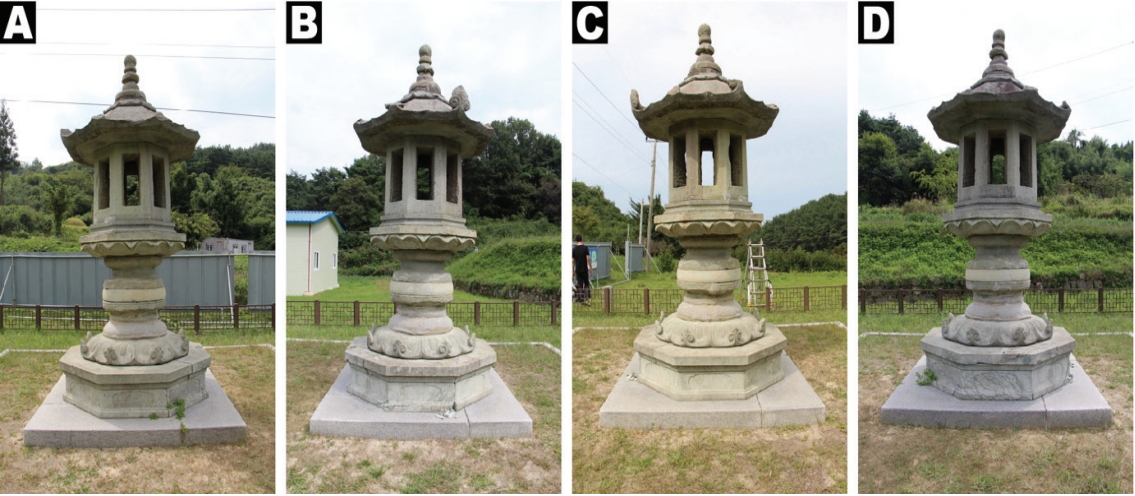
Figure 2.
Representative lithological characteristics and polarizing microphotographs of the stones. (A, B, C) KS-T1 of the original stones, (D, E, F) KS-T2 of the replacement stones in 1991 and (G, H, I) KS-T3 of the replacement stones in 2017.
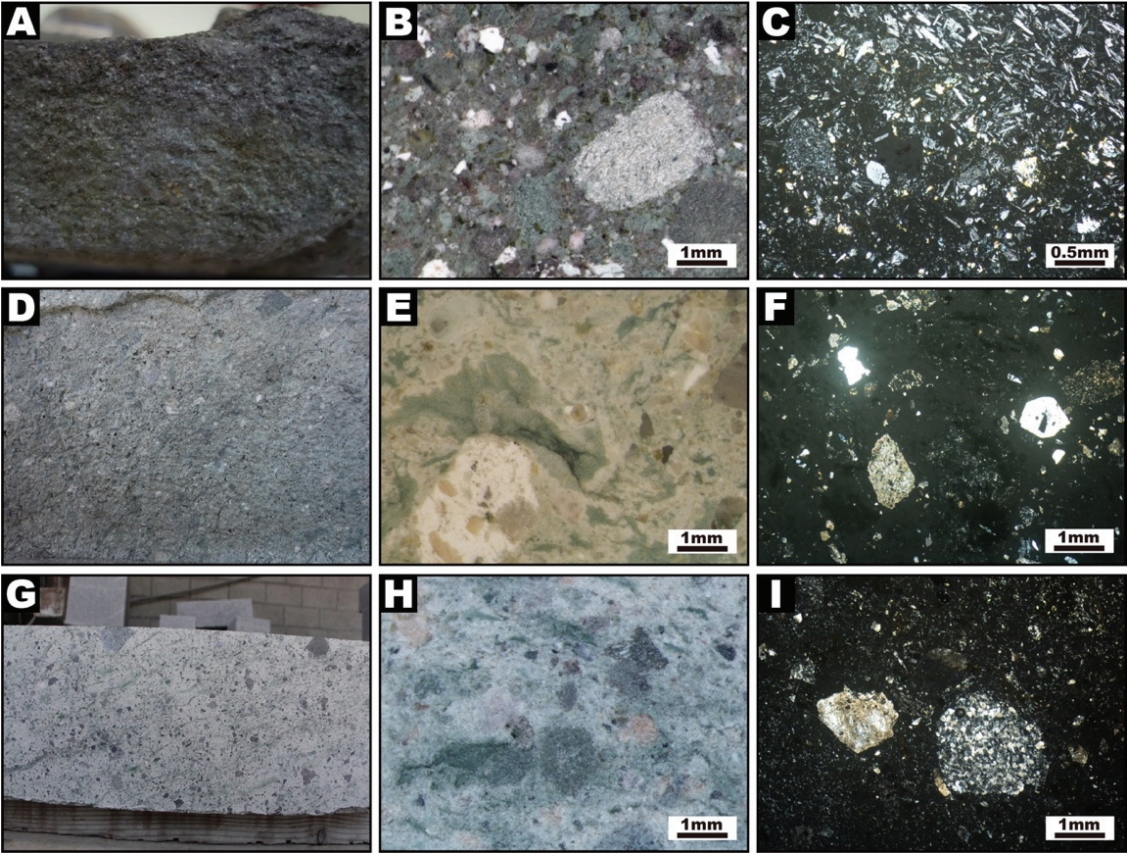
Figure 3.
XRD patterns of the stones. Q; quartz, K; K-feldspar, P; plagioclase. The numbers represent the same as those in Figure 2.

Figure 4.
Magnetic susceptibilities of the stones. The numbers represent the same as those in Figure 2.
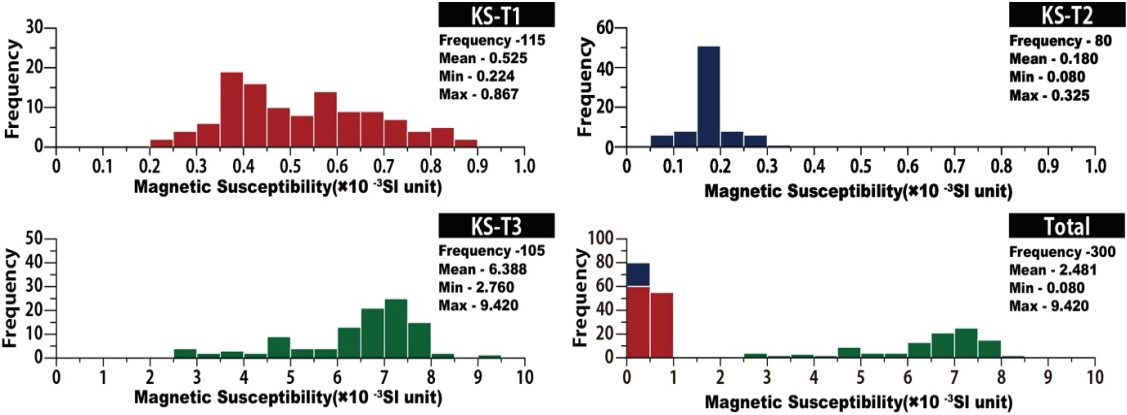
Figure 5.
Pore diameter distribution of the stones. The numbers represent the same as those in Figure 2.
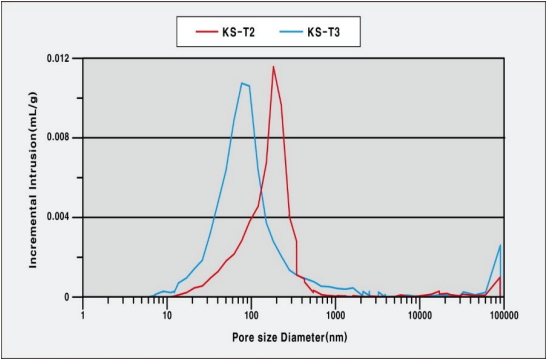
Figure 6.
Diagrams showing the normalized geochemical variations for the stones. The numbers represent the same as those in Figure 2.
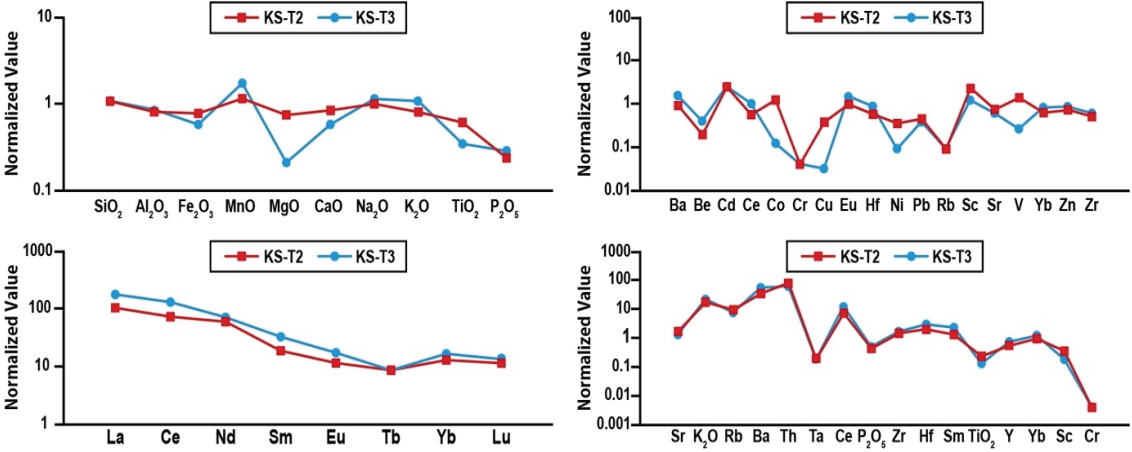
Figure 7.
Representative physical damage of the stones. (A) Various cracks on Hadaeseok, (B, C) Physical damage owing to the deterioration of the formerly treated resins, (D, E, F) Photographic areas for infrared thermography at the weathering parts and (G, H, I) Infrared thermograph images against the photographs of D, E and F.

Figure 8.
Representative chemical deterioration of the stones. (A) Black discoloration around the roof stone, (B) White discoloration inside the lamp stones and (C) Brown discoloration on the original stone.

Figure 9.
Measurement points showing the contaminants on the stone lantern. F; Fresh area, B; Black discoloration area, W; White discoloration area and R; Brown discoloration area.

Figure 10.
Results showing P-XRF analysis of the contaminants on the stones. (A) Variation of S content, (B) Ca content, (C) Mn content and (D) Cl content. The numbers represent the same as those in Figure 9.
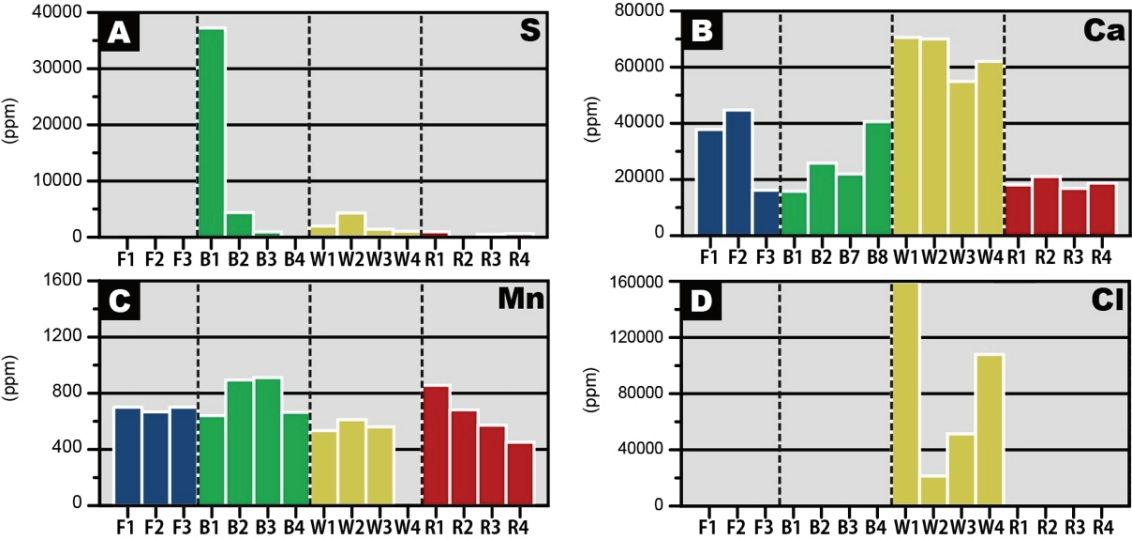
Figure 11.
Representative SEM-EDS results of the contaminants of the stones. (A) Black contaminants, (B, C) Color mapping analysis of the photo A, (D, E) White contaminants and (F) Lichen attached to the white contaminants. The numbers represent the same as those in the upper photos.

Table 1.
Composition of major (wt%), some minor, and rare-earth elements (ppm) of the stones
Table 2.
Summary of the deterioration rates of the stone lantern
REFERENCES
Cultural Heritage Administration, 1993, Research of repairs for cultural heritage of Korea in 1991, 763–793. (in Korean)
Fitzner, B. and Heinrichs, K., 2001, Damage diagnosis on stone monuments—Weathering forms, damage categories and damage indices, Stone Weathering and Atmospheric Pollution Network (SWAPNET), Decin, May 7-11, 11-56
Fitzner, B., Heinrichs, K. and La Bouchardiere, D., 2003, Weathering damage on Pharaonic sandstone monuments in Luxor-Egypt. Building and Environment, 38(9-10), 1089–1103.

Govindaraju, K., 1989, Compilation of working values and samples description for 272 geostandards, Geostandards Newsletter, 13(Special issue, July), 1-113
Iliev, I.G., 1966, An attempt to estimate the degree of weathering of instructive rocks from their physicomechanical properties, International Society for Rock Mechanics and Rock Engineering, Lisbon. September 25-October 1, 109–114
Jo, Y.H. and Lee, C.H., 2011, Making method of deterioration map and evaluation techniques of surface and threedimensional deterioration rate for stone cultural heritage. Journal of Conservation Science, 27(3), 251–260. (in Korean with English abstract)
Jo, Y.H., Lee, C.H. and Yoo, J.H., 2013, Study on applicability of passive infrared thermography analysis for blistering detection of stone cultural heritage. Journal of Conservation Science, 29(1), 55–67. (in Korean with English abstract)

Jo, Y.H. and Lee, C.H., 2014, Quantitative modeling of blistering zones by active thermography for deterioration evaluation of stone monuments. Journal of Cultural Heritage, 15(6), 621–627.

Jo, Y.H. and Lee, C.H., 2015, A study on selection of ultrasonic transducer and contact material for surface irregularities of stone cultural heritage. Journal of Conservation Science, 31(3), 267–278. (in Korean with English abstract)

Kahraman, S., 2002, Estimating the direct P-wave velocity value of intact rock from indirect laboratory measurements. International Journal of Rock Mechanics and Mining Sciences, 39(1), 101–104.

Kim, Y.H., 2005, The Compilations of archaeological data in Korea, Atlas of archaeological sites in Joseon dynasty 4, National Culture, 4, 500-501. (in Korean)
Koo, M.H., 2000, Review of the engraving record in stone lantern of Gaeseonsaji temple site at Damyang—Focused on land deal case of the 9th century in United Silla Kingdom. The Journal of History and Practical Thought Studies, 15•16, 59–80. (in Korean)
Lee, C.H. and Jo, Y.H., 2017, Correlation and correction factor between direct and indirect methods for the ultrasonic measurement of stone samples. Environmental Earth Science, 76(14), 477–489.


Lee, C.H., Kim, Y.T. and Lee, M.S., 2007, Provenance presumption for rock properties of the five storied stone pagoda in the Jeongrimsaji temple site, Buyeo, Korea. Journal of the Geological Society of Korea, 43(2), 183–196. (in Korean with English abstract)
Lee, C.H., Jo, Y.H. and Chun, Y.G., 2009, Establishment of ultrasonic measurement and correlations of direct-indirect method for weathering evaluation of stone cultural heritage. Journal of Conservation Science, 25(3), 233–244. (in Korean with English abstract)
Lee, C.H., Kim, M.Y., Jo, Y.H. and Lee, M.S., 2010, Conservation treatment based on material characteristics, provenance presumption and deterioration diagnosis of the seven-storied Jungwon Tappyeongri stone pagoda, Chungju, Korea. Korean Journal of Cultural Heritage Studies, 43(3), 4–25. (in Korean with English abstract)
Lee, C.H., Chun, Y.G. and Suh, M.C., 2012, Evaluation of slope stability and deterioration degree for Bangudae petroglyphs in Ulsan, Korea. Journal of Conservation Science, 28(2), 153–164. (in Korean with English abstract)

National Highway Cooperative Research Program, 1969, Identification of frost susceptible particles in concrete aggregates, Report 66, 1–62
National Research Institute of Cultural Heritage, 2001, Research of stone lanterns in Korea, Ⅱ. 13-29. (in Korean with English abstract)
Nockolds, S.R., 1954, Average chemical compositions of some igneous rocks. Bulletin of the Geological Society of America, 65(10), 1007–1032.

Park, S.M., Lee, M.S., Kim, J.H. and Lee, C.H., 2012, Material characteristics and deterioration assessment for multi-storied round shape stone pagoda of Unjusa temple, Hwasun, Korea. Korean Journal of Cultural Heritage Studies, 45(1), 86–101. (in Korean with English abstract)
Pearce, J.A., 1983, Role of sub-continental lithosphere in magma genesis at active continental margins. In: Hawkesworth C.J., Norry M.J., Continental basalts and mantle xenolith, Shiva, Nantwich, 230–349.
Taylor, S.R. and Maclennan, S.M., 1985, The continental crust: Its composition and evolution, Blackwell, Oxford, 312–312.
- TOOLS
-
METRICS

-
- 2 Crossref
- 6,479 View
- 121 Download
-
Related articles in
J. Conserv. Sci.





